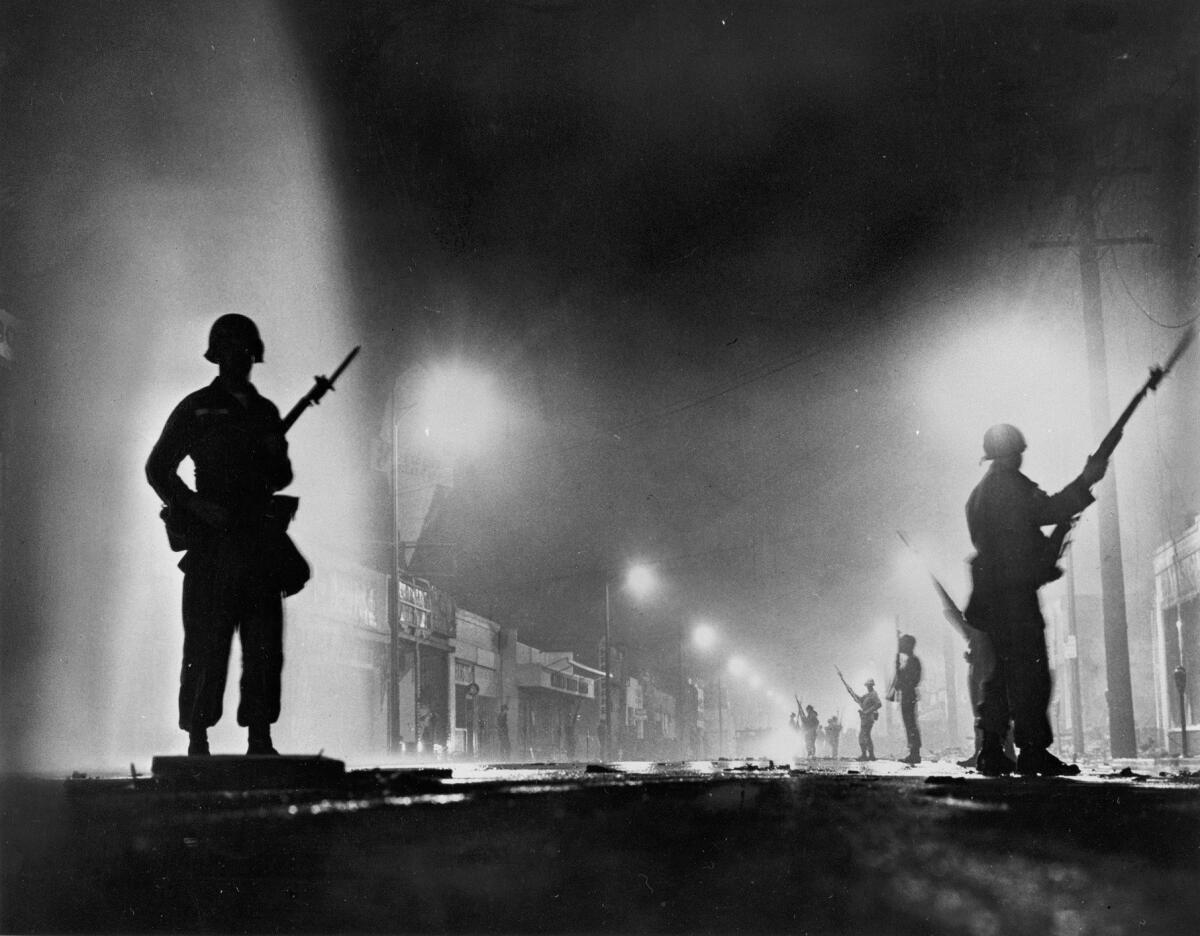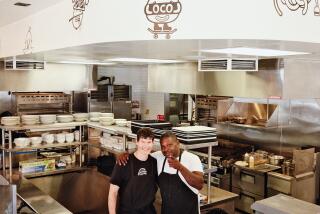Editorial: Watts riots, 50 years later: What has L.A. learned, and done?

National Guard troops secure a stretch of 103rd Street, dubbed Charcoal Alley, in Watts to help L.A. authorities restore order on August 13, 1965. The riots, sparked by the arrest of a black motorist for drunk driving, lasted for six days.
We look to anniversaries of momentous events — the beginning of World War I (100 years, last July), the end of the Civil War (150 years, in April), the voting rights march from Selma to Montgomery, Ala., (50 years, in March) — to note the passage of time, to measure the progress of the generations, to indulge in nostalgia. The approach of the half-century mark since the Los Angeles meltdown that began near Watts summons a less celebratory response.
There is so much that is depressingly up-to-date about the violence that was then known as the Los Angeles riots (the event has since been mentally compartmentalized into the Watts riots, even though it took three days for the violence to reach Watts). There was the traffic stop of a black driver by a white Highway Patrol officer, followed by an arrest, then anger, uprising, armed clash. Revelations about long-standing police practices; denial; promises to investigate. Much of the narrative of those August days could easily have been pulled together from news reports written any time over the last five decades but especially in the last year, from Ferguson, Mo., to Baltimore to New York and back to Los Angeles.
Fifty years is the better part of a lifetime, and people who lived in Los Angeles in 1965 and are still living here today see many of the same circumstances that led, beginning on the hot evening of Aug. 11, to six days of violence. So what do we do now? How do we observe the coming anniversary?
One place to start might be the report of the commission, appointed by Gov. Pat Brown (the current governor’s father) and headed by John A. McCone, former director of the Central Intelligence Agency, to determine what happened and why, and to recommend steps to be taken to ensure that such violence would never recur.
The McCone Commission noted, with some unwarranted surprise, the difference between life in places like Watts and life for what were then the majority non-black, non-Latino Angelenos. “In examining the sickness in the center of our city, what has depressed and stunned us most is the dull, devastating spiral of failure that awaits the average disadvantaged child in the urban core,” the commission reported.
But why such a spiral? The commission was too ready to assign the blame to migration of rural poor black Southerners to Los Angeles, bringing little education and little ability to make a living in the city. The commission spoke of race but not of racism. It noted that in African American housing, employment and wages, Los Angeles was the best city in the nation. It said little about, or outright denied, the existence of policing practices meant to humiliate, prisons geared toward punishment without rehabilitation, political processes that systematically excluded African Americans from political representation.
Still, the commission acknowledged that there were not enough schools, affordable housing and accessible medical care. The commission offered an ambitious program of improvements and opportunities, and official Los Angeles responded by creating institutions such as the Martin Luther King Jr. medical center in Willowbrook, an unincorporated county neighborhood just outside of Watts; schools such as the Los Angeles Unified School District’s Locke High School, also near Watts; and continued reliance for housing on federal projects such as Nickerson Gardens, Imperial Courts and Jordan Downs, all in Watts.
They all went through their own dull, devastating spirals of failure.
In an era in which the key to successful public institutions was seen to be community self-management and self-determination, public officials too often responded with neglect. The hospital, for example, was sometimes seen as a kind of ransom. It was as though county leaders offered some money and told black Los Angeles, “Here, run this place, and leave the rest of us alone.” Many physicians and staff responded as though their very jobs were an entitlement regardless of the quality of care they provided. MLK medical center became known as “Killer King,” and by the time the county tried to save it, it was too late. It closed in August 2007, the 42nd anniversary of the violence that spurred its creation, the 35th anniversary of its opening.
At Locke, as at other public schools around the city but especially in South L.A., students complained that the quality of education was poor. The housing projects intended to offer people sufficient shelter while they gained an education, trained for work and broke the cycle of poverty became permanent homes for multiple generations and played a major role in sustaining some of the city’s most violent street gangs.
The path through government investment, on the one side, and community self-determination, on the other, was laid down poorly. It must be re-mapped and re-walked before the generation that grew up in the aftermath of the Watts riots can say it has completed its business.
The process is under way at the new Martin Luther King Jr. Community Hospital, set for its ceremonial reopening next month but already serving patients under a governance structure separate from the county and with employees who are not part of the county civil service system. Locke High School is now Alain LeRoy Locke College Preparatory Academy and is run by charter school operator Green Dot rather than by the school district. Jordan Downs is in the midst of a remake, with its residents part of the planning process.
It may be tempting to see some magic in the formula for transforming failed institutions into programs that work. A little private sector, a little public, a little community control, a little public oversight, in just the right amounts. But reinvention and redemption are seldom that simple. Besides, they cannot work in a vacuum — not without dealing with racism, segregation, over-incarceration and other societal problems. Meanwhile, these institutions, and others like them and still others yet to be created, require support and examination if they are to avoid the spiral of failure.
Follow the Opinion section on Twitter @latimesopinion and Facebook
More to Read
A cure for the common opinion
Get thought-provoking perspectives with our weekly newsletter.
You may occasionally receive promotional content from the Los Angeles Times.










